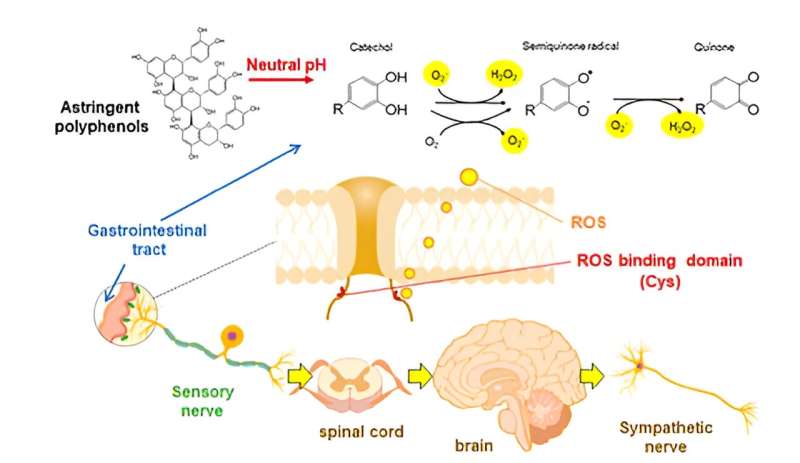This article has been reviewed according to Science X's editorial process and policies. Editors have highlighted the following attributes while ensuring the content's credibility:
fact-checked
trusted source
proofread
Deciphering the role of bitter and astringent polyphenols in promoting well-being

Polyphenols are powerful plant metabolites known for their antioxidant properties, offering potential health benefits and protection against various diseases. With over 8,000 identified varieties, these substances are found in plentiful amounts in various fruits, vegetables, tea, and coffee. Besides adding color and flavor to foods, polyphenols play a crucial role in promoting health and overall well-being.
Despite their bitter and astringent taste, recent studies indicate that they may hold the key to a range of health benefits, including the prevention of cardiovascular diseases, neurodegenerative conditions, and age-related sensory decline. However, there are significant gaps in understanding how exactly they exert these beneficial effects, particularly in terms of their interactions with the body.
To fill this knowledge gap, Professor Naomi Osakabe, along with Dr. Yasuyuki Fujii from Shibaura Institute of Technology and Professor Vittorio Calabrese from the University of Catania, Italy, explored the interaction between polyphenols and human health and its consequent impact.
The findings of their study were published in Biomolecules.
Sharing the inspiration behind their work, Prof. Osakabe remarks, "Although many researchers have conducted polyphenol research for more than 30 years, a major challenge has been to elucidate the mechanisms behind their beneficial health effects." This review attempts to understand the ways in which polyphenols interact with sensory receptors in the gastrointestinal tract, ultimately influencing metabolic pathways and promoting overall well-being.
Epidemiological evidence has long established the protective effects of polyphenols against various chronic conditions such as cardiovascular diseases, metabolic disorders, neurodegenerative diseases, and age-related degeneration of sensory organs. The major challenge in decoding the underlying mechanism of action is their unavailability in blood and/or organs. Polyphenols are usually broken down in the lower gut by intestinal bacteria and excreted in feces.
Recent studies have reported that ingested dietary polyphenols can alter the composition of the gut microflora, altering the composition of secondary metabolites in the colon. It is hypothesized that these altered metabolites may be absorbed and affect metabolic and cognitive functions. However, the type and amount of polyphenol varies greatly with diet and individuals making it quite difficult to establish a causal correlation.
Sensory receptors are specialized cells located close to nerve endings and are widely distributed in specialized organs such as eyes, ears, and even the gut. In recent years, sensory nutrition, a new field of study examining the cross-talk between ingested food or beverages, the brain, and its impact on human behavior, has garnered significant attention. Some reports have suggested that food signals contribute to homeostasis via gut-based sensory receptors.
Delving deeper to unearth the association between polyphenols and the gut, researchers in this study revealed that polyphenols, which are inherently bitter in taste, interact with the bitter taste receptor, the taste receptor 2 (T2R) receptors.
Furthermore, some studies found that until polyphenols are excreted, they stay in contact with I-, K-, and L- cells of the intestine expressing T2Rs or with gastrointestinal sensory nerves and epithelial cells that express TRP channels for an extended time. The astringency of polyphenols was suggested to be a somatosensory perception (a sensation that can occur anywhere in the body) and was correlated with improved blood pressure and risk factors for heart diseases.
Polyphenols caused a marked increase in blood flow-dependent vasorelaxation (FMD) levels at moderate doses, known as the hormetic effect. Researchers have found that astringent polyphenols interact with transient receptor potential (TRP) channels. However, further investigation is needed to understand this interaction clearly. These findings strongly suggested that polyphenols exert their beneficial effects via sensory receptors of the gastrointestinal tract.
The astringent and bitter properties of polyphenols offer various therapeutic properties. An experimental animal study demonstrated that repeated intake of stringent polyphenols reduced FMD response significantly along with blood pressure. Another study reported that consumption of bitter polyphenols increased gastrointestinal hormone secretion, thereby regulating blood glucose levels and glucose tolerance.
Astringent polyphenols have been observed to regulate the hypothalamic-pituitary-adrenal (HPA) axis activation, thereby improving mood and memory function. Bitter and astringent perception of polyphenols have also been attributed to their anti-obesity effects.
The integration of polyphenol-rich ingredients in functional beverages and snacks, could therefore revolutionize the way we approach nutrition and disease prevention. Elaborating on the long-term impact of their work, Prof. Osakabe explains, "Our study is the first to identify that sensory stimuli in food can promote homeostasis and pave the way for the development of novel food products aimed at promoting human health."
Overall, by comprehensively looking at the underlying mechanisms responsible for the beneficial effects of polyphenols, this review represents a significant step forward in our understanding of the health effects of polyphenols and could pave the way toward innovative dietary interventions for well-being.
More information: Naomi Osakabe et al, Sensory Nutrition and Bitterness and Astringency of Polyphenols, Biomolecules (2024). DOI: 10.3390/biom14020234


















